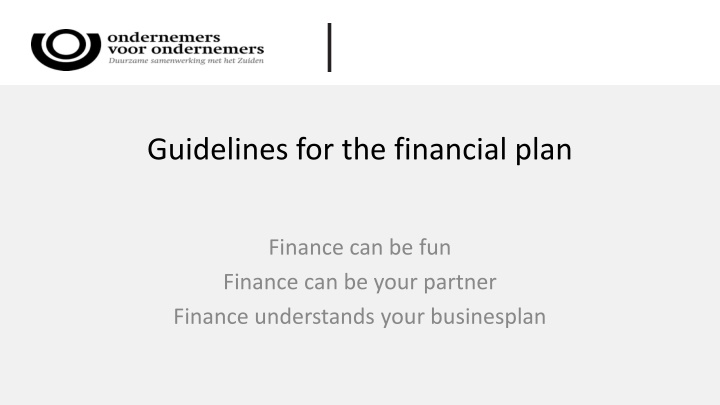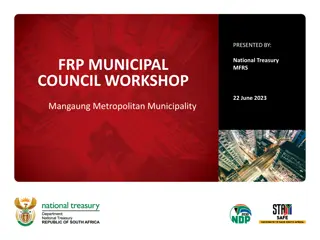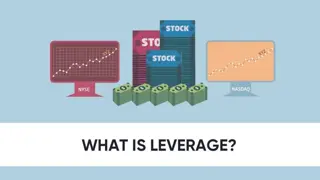Guidelines for Financial Plan
Create a solid financial plan with these guidelines focusing on profit and loss accounts, sales forecasts, expenses, investments, cash flow statements, and balance sheets. Understand the key points of a P&L statement and learn to prepare a profit and loss account efficiently.
Uploaded on Mar 03, 2025 | 0 Views
Download Presentation

Please find below an Image/Link to download the presentation.
The content on the website is provided AS IS for your information and personal use only. It may not be sold, licensed, or shared on other websites without obtaining consent from the author.If you encounter any issues during the download, it is possible that the publisher has removed the file from their server.
You are allowed to download the files provided on this website for personal or commercial use, subject to the condition that they are used lawfully. All files are the property of their respective owners.
The content on the website is provided AS IS for your information and personal use only. It may not be sold, licensed, or shared on other websites without obtaining consent from the author.
E N D
Presentation Transcript
Guidelines for the financial plan Finance can be fun Finance can be your partner Finance understands your businesplan
Agenda Showing the link businessmodel -> Financial Model Profit & loss account : composition of income statement Sales forecasts and gross margins Overview of expenses Investments : fixed assets Terms of working capital The purpose and the composition of the Cash flow statement Balance sheet 2
Business and financial model Business model Description of your project, your value proposition and your objectives Converted to numbers to show how you gain money To connect financial model Revenues Costs Expenses and investments Working capital Income statement + cashflow (a dynamic representation) Balance sheet (periodic one shot position) + 3
P & L major attention points All items are expressed without the v.a.t. (value added taxes) Revenue = turnover => your sales Gross margin = revenue direct cost of used goods Operating expenses (marketing, staff, office, travel, insurance, maintenance, third party costs, ) EBITDA -> earnings before intrest/taxes/depreciations/amortization) = gross margin minus operation expenses Depreciations/amortization of your investments depending on the economic lifespan EBIT -> earnings before intrest and taxes = EBITDA minus depreciations/amortization Financial costs (intrest, other charges) Income taxes Net profit 4
Example preparation of a profit and loss account (or incomestatement) Profit & Loss Statement EDITED IN .. Year 1 Year 1 January February March April May June July August Septemb. October Nov Dec Yeartotal Amount Amount Amount Amount Amount Amount Amount Amount Amount Amount Amount Amount Amount % Trade revenues 0,00 0,00 0,00 0,00 0,00 0,00 0,00 0,00 0,00 0,00 0,00 0,00 0,0 100 Other revenues 0,00 0,00 0,00 0,00 0,00 0,00 0,00 0,00 0,00 0,00 0,00 0,00 0,0 Total revenues 0,00 0,00 0,00 0,00 0,00 0,00 0,00 0,00 0,00 0,00 0,00 0,00 0,0 Use of raw materials 0,00 0,00 0,00 0,00 0,00 0,00 0,00 0,00 0,00 0,00 0,00 0,00 0,0 (Stockvariation *) 0,00 0,00 0,00 0,00 0,00 0,00 0,00 0,00 0,00 0,00 0,00 0,00 0,0 #DELING.DOO R.0! Cost of Goods * 0,00 0,00 0,00 0,00 0,00 0,00 0,00 0,00 0,00 0,00 0,00 0,00 0,0 #DELING.DOO R.0! Gross Margin 0,00 0,00 0,00 0,00 0,00 0,00 0,00 0,00 0,00 0,00 0,00 0,00 0,0 Marketing costs 0,00 0,00 0,00 0,00 0,00 0,00 0,00 0,00 0,00 0,00 0,00 0,00 0,0 Staff costs 0,00 0,00 0,00 0,00 0,00 0,00 0,00 0,00 0,00 0,00 0,00 0,00 0,0 Office costs 0,00 0,00 0,00 0,00 0,00 0,00 0,00 0,00 0,00 0,00 0,00 0,00 0,0 Travel costs 0,00 0,00 0,00 0,00 0,00 0,00 0,00 0,00 0,00 0,00 0,00 0,00 0,0 Insurance costs 0,00 0,00 0,00 0,00 0,00 0,00 0,00 0,00 0,00 0,00 0,00 0,00 0,0 Maintenance costs 0,00 0,00 0,00 0,00 0,00 0,00 0,00 0,00 0,00 0,00 0,00 0,00 0,0 Third parties costs 0,00 0,00 0,00 0,00 0,00 0,00 0,00 0,00 0,00 0,00 0,00 0,00 0,0 Total operationel costs 0,00 0,00 0,00 0,00 0,00 0,00 0,00 0,00 0,00 0,00 0,00 0,00 0,0 #DELING.DOO R.0! Income from operations = EBITDA 0,00 0,00 0,00 0,00 0,00 0,00 0,00 0,00 0,00 0,00 0,00 0,00 0,0 Depreciations 0,00 0,00 0,00 0,00 0,00 0,00 0,00 0,00 0,00 0,00 0,00 0,00 0,0 #DELING.DOO R.0! Net income from operations = EBIT 0,00 0,00 0,00 0,00 0,00 0,00 0,00 0,00 0,00 0,00 0,00 0,00 0,0 Intrest ** 0,00 0,00 0,00 0,0 Bankcharges #DELING.DOO R.0! Gross Profit BEFORE TAXES 0,00 0,00 0,00 0,00 0,00 0,00 0,00 0,00 0,00 0,00 0,00 0,00 0,00 Incometax 0,0 #DELING.DOO R.0! NET PROFIT 0,0 0,0 0,0 0,0 0,0 0,0 0,0 0,0 0,0 0,0 0,0 0,0 0,0 5
Defining the Sales & Gross Margin forecast Per product : determine your sales unit define your salesprice per unit ( see next slide) define the planned quantities mention the cost of sales per unit (suggestion to keep it simple : to avoid double counting of labor costs and energy costs, limit yourself to the cost of the raw materials used + possibly the cost of the packaging) Please do so for the next 12 or 24 months so that the evolution is visualised Important remark : The name product is generic and can represent a trade product, a physical manufactured or assembled product, a project, or a service ! 6
Suggestions for price-setting of your sales unit Try to find out what you need to prepare your product ready to sell : . What is the cost of raw material needed . How many hours labourwork multiplied by the cost per hour . What is the estimated cost of energy consumption . Multiply this total cost with a certain factor 1, xx or 2, xx to define your salesprice Search - if possible - for the existing market price, just to compare and to check if your price is suitable and feasible 7
Exercise A Sales & gross margin description Identify a specific product Per product : Composition of the product and sales unit Sales price per unit your cost of sales per unit Quantity per month Calculate the gross margin per month, per year 8
2. Detail expenses Marketing costs : research, consultancy, advertizing Staff costs : employees, administrative people, salespeople, managers Office costs : rent, communication, utilities, stationary, cleaning costs Sales travel costs : depends on number of sales people and managers Insurances : building, responsability of the company, people Maintenance costs : maintenance machinery, maintenance equipment Third party fees : transport, advisers, legal, accountancy, cleaning cy Remarks: TO DO : per month for the first 12 or 24 months, when applicable Some costs are annual subject to an index : define the index as usual in your country 9
Investment plan Complete the planned investments : List these for year 1 If you plan investments for the following year(s) list them too Concrete for year 2 : fill the amounts in the corresponding column of year 2 and do the same for year 3. Complete a depreciation table over time depending the economic life cycle 10
Exercise B Discuss the following steps with your coaches with regard to the list of expenses and with regard to the investment plan: which elements are relevant to you and / or which elements are not relevant Expenses detail Investment plan Integration P&L 11
Determine the need of working capital You define at the end of each period the value of : Stock : raw materials, semi-finished and finished goods Receivables : the amount of invoices of customers who still have to pay Payables : the invoices of the suppliers that still have to be paid The need for working capital = stock + receivables payables On yearbasis you calculate the average of the 12 monthly amounts 12
Exercise C Now discuss together with your coaches The interpretation of your working capital The financial sources you have in mind 13
Showing the cash flow statement Why ? Showing the forecast of your cashflow is important to proof that your business proposal is sufficiently profitable to bear all the costs (expenses and financial commitments) Composition : Starting from the cash/bank position at the beginning of a period (own company money ) + net profit + amortization/depreciation of that period Minus need for working capital (stock, accounts receivables, payables) (For the first year and for the second year and further on the difference in need versus the year before) Minus capital expenditures for your investments Plus received loans Minus repayments of loan(s) -> Results in the cash position at the end of that period : should be at least zero ! 14
Short summary of the step by step development of a financial plan 1. Sales and gross margin forecast Ingredi nts for the Profit & Loss 2. Detail of various expenses 3. Investment budget Integration into a 4. Profit & Loss statement Ingredi nts for the cashflow 5. Working capital calculation 6. Financing sources Integration into a 7. Cashflow statement Consolidation in a 8. Balance sheet budget Financially controlled by 9. Ratio-analysis 15
Balance sheet simplified Assets Where the money goes to Fixed assets Real estate : land, buildings Rolling material : vans, cars, motorcycles Machinery,equipment and furniture Equity & Liabilities Where the money comes from Equity Share holders money Reserves and profits Long term debts Short term assets Stock Receivables Liquid funds : cash / bank Short term liabilities . Reimbursements within the year of LT loans . Payables Working capital 16
Overview of fin-fun We wish you : the necessary diligence and attention to fully develop your financial plan Remember the overview : Sales & Gross Margin Balance sheet Expenses Cashflow statement Investment budget Working capital & Financing sources Profit & Loss Statement 17
Finally to help you In an Excel sheet we provide you with a zero template for the preparation of your financial plan, whereby you only have to fill in the yellow zones ! while the other cells are calculated automatically 18























